Giving bees a place to live
| |
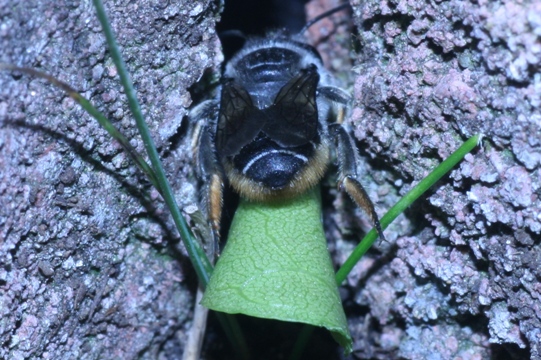 |
|
| |
A leafcutter bee (Megachile sp.) entering its nest with a newly cut piece of leaf. The leaf is curled into a hollow cylinder and used to line the tunnels. |
|
Most people provide flowers for bees without thinking where these animals will lay eggs and raise offspring. Our gardens are places where we can provide simple accommodations for bees to take advantage of. By providing nesting sites, you are at the very least lowering the distance that the bee needs to travel to find its food resource and you may be helping a species of bee that is having a difficult time finding a suitable location to reproduce. Bees can end up expending vast amounts of energy just getting from their abode to their food source.
| |
|
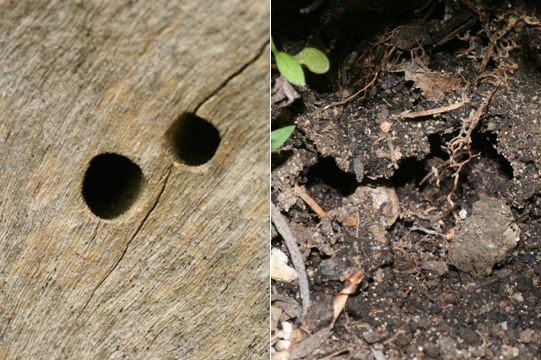 |
|
| |
|
The holes in the wood have most likely been excavated by longhorn beetles. The Asian longhorn beetle is well known for doing a large amount of damage to ash trees, but there are many native longhorn species that form an important part of the community by helping to break down old wood and provide nesting sites for bees. The holes in the soil shown here have been excavated by Andrenine bees. |
|
Bees nest in holes in wood, in broken stems, or they nest underground in holes. It is common for bees to both construct their own holes and to nest in holes made by other animals. In some cases, bees lay eggs in holes occupied by other bees. Solitary wasps also may build their external nests from paper, mud or sand. In order of importance, here are some things that you can do:
1) Provide natural nesting sites by leaving some bare patches of soil with no mulch for soil dwelling bees.
| |
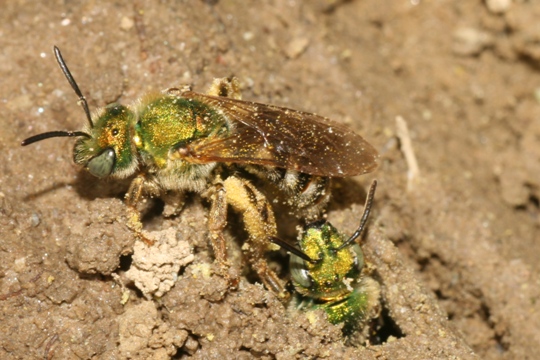 |
|
| |
Agapostemon virescens, a type of sweat bee, lives communally. The females share the same nest entrance but have their own brood cells that they take responsibility for. Here they are nesting in bare ground. |
|
2) Provide natural nesting sites by cutting the top off hollow stems. You may be accustomed to cutting down stems to the ground in the fall because it makes your garden look neat and tidy. That is the opposite of what small creatures need. Instead, wait till spring and you can cut down dead stems down to 2 feet (60 cm) in height. Your plants will grow up around these old stems so they will not be noticeable. By the following spring, when you repeat this, the stems will have decomposed.
3) Provide natural nesting sites for bees using snags and logs. Beetles will carve out tunnels that can be used by bees for nesting in.
According to the xerces society, approximately 30% of bees nest in holes made by beetle larvae in snags and fallen logs. If you can, please leave snags or fallen logs in your back yard because they are a bonanza for wildlife.
4) Provide artificial nesting sites for bees to use in your garden.
The basic principle is the same no matter how you construct your bee house. The inside of the tube should be smooth and about six inches long. Bees prefer laying female eggs at the distal end of the hole and male eggs near the entrance. The eggs or larvae near the entrance have lower survival chances.
The concern that is raised most often is whether more people will get stung if we facilitate bee nesting. Only the honey bee is known for being able to sting and being likely to sting because it has to protect vast stores of honey from potential predators. Other eusocial bees such as bumblebees are far less aggressive. In fact, most bee species are not highly eusocial, living in small colonies or in more solitary conditions. These types of bees will not sting you. The thousands of native bees that exist in N. America either cannot sting humans or are not prone to stinging. If you already have flowers in your garden for pollinators, then you already have bees around anyway.
Another concern raised that bees mostly do not use artificial nesting sites. This is true, but there are still 30 species of bee in Southern Ontario that will make use of these dwellings in addition to some wasps.
Another concern is that bee hotels provide a breeding ground for bee parasites. If you decided to provide a bee hotel, you must also take on the responsibility of cleaning out the holes properly each year. Even if you clean the nest, the high density of holes in one place will make it easier for parasites to find hosts. The ongoing question is who benefits more from artificial nests; the hosts or the parasites. Nests made of blocks of wood or resin with some holes drilled out are difficult to clean. You can avoid this problem by using straw inserts that are replaced each year. Also see some suggestions below.
Many bee species make their own holes for nesting in specific types of soil. Gardeners should leave some patches of soil bare and completely undisturbed, and other patches with some leaf litter on top. Some bees like the leaf cutter bee shown above prefer vertical entrance holes while others prefer near horizontal grades.
| |
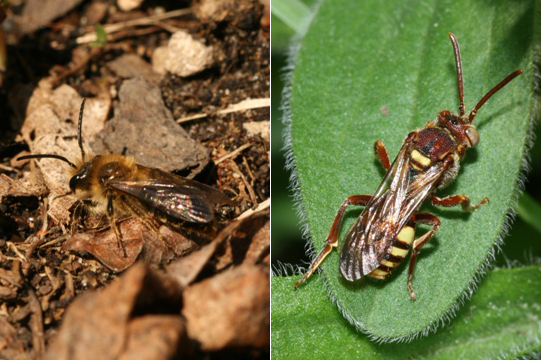 |
|
| |
The holes in the soil shown here have been excavated by Andrena barbilabris (shown above left) which specialises in sandy soil. These holes also provide a home for Nomadine bees, which are kleptoparasitic, as well as other parasites. |
|
|
These patches do not have to be too large and can be surrounded by plants to make them less noticeable. If you are going to plant or transplant, then do so in early spring in beds where bees are nesting. Disturbing the soil at any other time could destroy the nesting site for that year.
The current gardening practice of mulching with wood chips that biodegrade slowly has made it far more difficult for these types of bees to find suitable locations in gardens. Alternatively, you could try filling large decorated pots with sandy soil and leaving them on your patio.
Many different bee species use bare patches of ground to nest in. You can try a flat patch vs. a steep patch to see if you get different species. Vertical entry points into the soil may well be used by leaf cutter bees.
This bamboo bee house is easy to make and it is the sort of project you might do with a kid to get them interested. Buy some bamboo canes from a garden centre and saw through the cane just after the joint so that one end remains closed. If the open end is completely covered with pith, then take a screw and push a hole through it. The disadvantage is that you will have to replace these nests every two years to avoid problems with parasites. One advantage they have is that the holes are different sizes which attract different bees. Tie them together using a strong tape or string and then attach them to a fence where they can get some morning sun.
| |
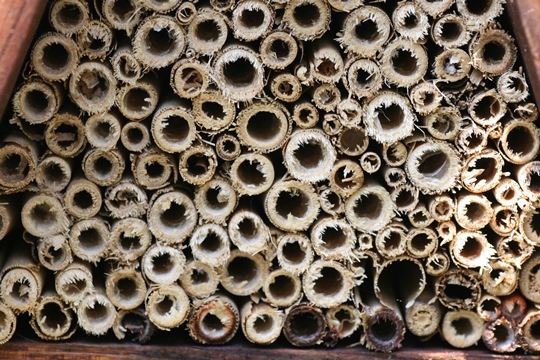 |
|
| |
Even the spaces between stems may serve as a cavity for bees |
|
If you want to avoid buying anything, then you can find plenty of plants that have hollow stems. Look for plants that are members of the following families: horsetails; rushes; grasses; carrot; and relatives. In my own garden, I use Coreopsis trypteris and Agastache nepetoides. Several members of the mint and aster families have hollow stems.
This is a bee house made out of corrugated plastic that I bought from a commercial provider. I cut up some cedar wood and screwed the pieces together to house the plastic. The advantage of this system is that you can easily replace the plastic. Each winter, the plastic part is replaced with another piece that has already been cleaned. The plastic that is removed can be stored somewhere cold over the winter and left out in the spring to release the overwintering bees. It is then washed in a bleach solution to clean it and so that it can be reused the following year. This plastic has holes all the same size which limits the number of species that use it. It is designed for mason bees that are important pollinators for spring flowering plants and trees.
| |
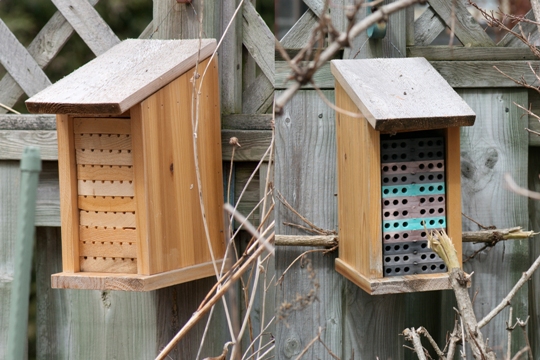 |
|
| |
The houses are pre-fabricated and the layered design allows for easy cleaning. If the houses have holes of different sizes, then different bee species are accommodated. |
|
These bee houses have been completely made by the provider. One uses wood while the other uses plastic. The layers come apart easily so that the current crop of bees can be removed. The layers are then scraped out in a few minutes; reassembled using a piece of electrical tape around the outside; and then placed back in the box ready to use. At the top, there is a flap to house the bee pupae that are removed for the rest of the winter. After many years, my preference remains for wooden nest boxes.
| |
 |
|
| |
If the bees are not removed in early winter, then they should continue to remain in the bee house until they emerge. These are Osmia sp. that emerge when the first blooms are present. Inside one of the cases, you can see a fully developed adult about to emerge. If a larva fails to complete its life cycle for any reason, it leaves behind the pollen as seen in the cells that are still full of powder. |
|
A female bee goes to the deepest part of the tube and lays an egg. She then collects pollen to furnish the bee larva with food. She seals off the egg and pollen with a material like mud, leaves or plant hairs and then lays the next egg. This is repeated over and over again until the hole is filled. Each hole in a bee house can accommodate up to about 20 bee pupae depending on the size of the cell. By the end of the summer, Osmia sp. are fully developed but remain inside their cases until the following spring.
| |
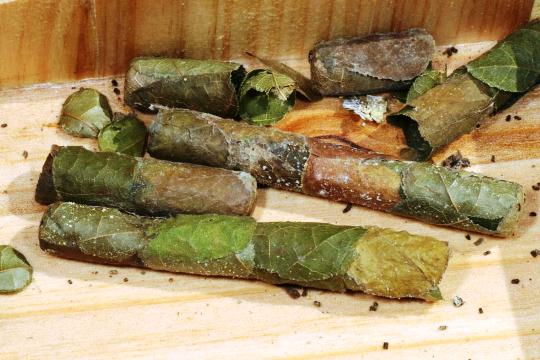 |
|
| |
The leafcutter bees make their cases out of leaves. |
|
Beneficial wasps may all use bee hotels and this should be encouraged. Their life cycles are different in that they will remain as a larva till spring. They pupate and emerge as adults within a couple of weeks. Wasp larvae may be much bigger than bees using the hotel, so there will be fewer cells in each hole.
| |
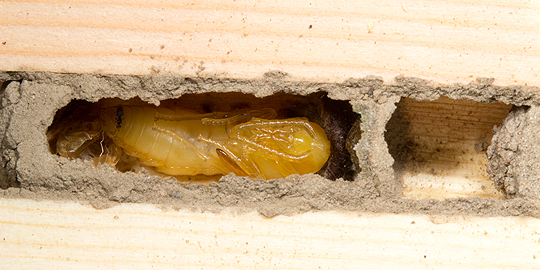 |
|
| |
This wasp has just pupated, which involves inverting the wings so that they are now external organs These wasps have vestibules, which are sealed off spaces, to separate each cell. |
|
If you have lots of pollinators in your garden, you also have lots of pests. Encouraging beneficial wasps to reproduce in your garden is a great way to keep these pests under control without the use of pesticide. Most commercial providers of bee houses give you horizontal holes, but some bees and wasps actually prefer vertical holes. A vertical tube will mimic a broken hollow stem. Try placing tubes at different angles and see what results you get.
| |
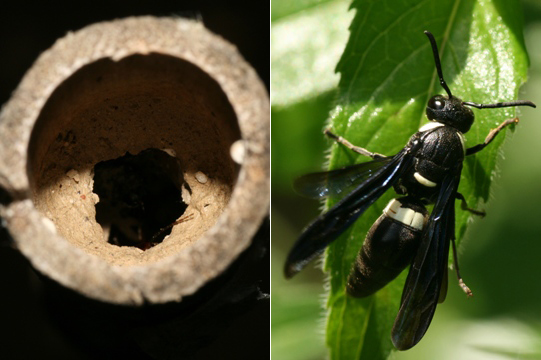 |
|
| |
The mason wasp shown here, Monobia quadridens, is a great addition to a garden because it helps to keep certain moth caterpillars under control. It will take advantage of vertical garden canes placed in the ground to support plants. It uses mud to seal up each cell, which is provided with a paralysed caterpillar to feed the larva. |
|
Bumblebees nest underground in holes that are already excavated such as old mouse holes. You can buy ready-made boxes over the internet or you can make your own. This is probably the most time-consuming suggestion and least effective on this page due to low occupancy rates.



